Estado de Hidalgo notes
Having obtained Carranza agreement in an accord dated 21 March 1915, on 29 March General Alfredo J. Machuca, authorised an issue of vales, for 5c, 10c, 20c and 50c, guaranteed by $500,000 in bronze coins deposited in the Tesorería General del EstadoPeriódico Oficial, Hidalgo, Tomo LXVIII, Núm. 30, 8 May 1915. The notes, to be dated 1 May, were to be initialed by the Governor or the Secretario de Gobernación or Secretario de Hacienda.. They would be redeemed by the Tesorería del Estado when presented in multiples of $50. In accordance with this decree Machuca issued
| Number | Total value | |
| 20c | 75,024 | $18,756.00 |
| 25c | 120,000 | 30,000.00 |
| 50c | 600,000 | 300,000.00 |
| $348,756.00 |
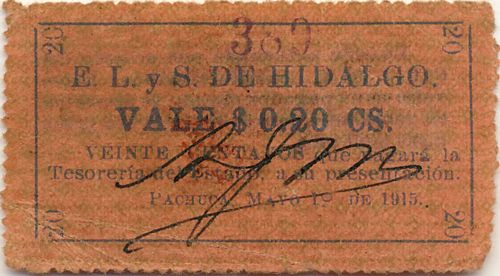
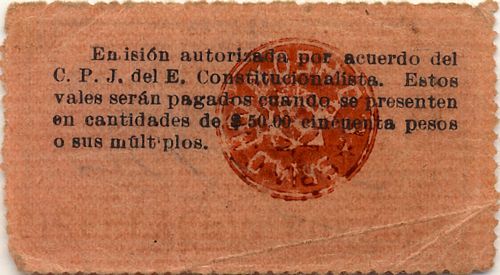
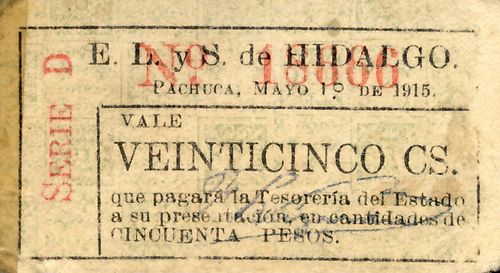
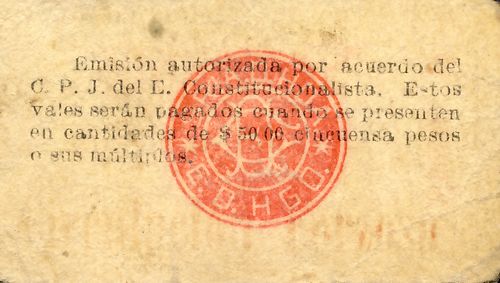
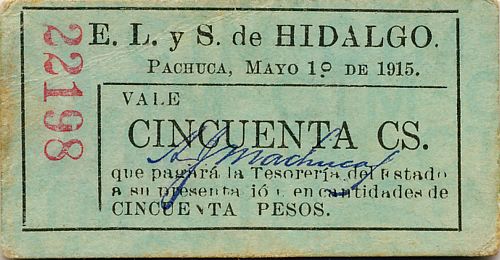
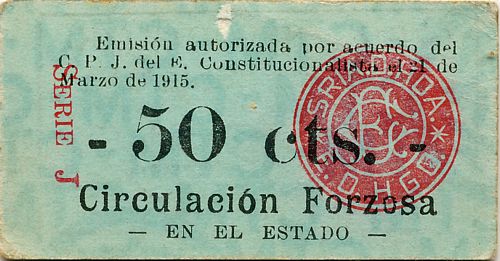
The 20c were red and of papel de china so the public nicknamed them palomas (doves) because they blew away in the Pachuca breeze whilst the 50c notes were green and so called pericos (parrots)Teodomiro Manzano, Anales del Estado de Hidalgo, 2a parte, p150-151. They were also noted for their dirty state. A local paper published this poem
Hay en esta unos papeles
que son de mugre pasteles
y han dado en llamarse “vales”
porque no hay medios, ni reales,
ni pesetas ni tostones,
ni pesos, y ni a jalones
se consigue algo de plata
y se ha metido la pata
con esos sucios papeles
que son de mugre pasteles,
y contienen más microbios
que besos que se dan los novios
y pelos tienen los bueyes,
que pulque dan los magueyes
y arenas hay en la tierra,
más que muertos en la guerra,
y que estrellas en el cielo,
más que arenas en el suelo,
más que peces en los mares,
pues tienen a centenares
microbios, de tal manera
que esos “vales” más valiera
para agravio de desdichas
en vez de ellos hacer fichas
de estaño, latón o lata,
de cobre o cuero de rata,
de barro, vidrio o madero,
pero de cualquier manera
no agraviar tanto a la higiene,
pues cada Vale contiene
cien mil veces más microbios,
que besos se dan los novios,
que pulque dan los magueyes
y…pelos tienen los bueyes.
Acuñador.
On 1 May the government paid its employees in 25c and 50c vales.
During Miguel Gómez Noriega’s administration (3 July to 2 August) he ordered the issue of $29,000 in 10c cartones, to replace the 20c notes which had been printed on thin paper and were useless.
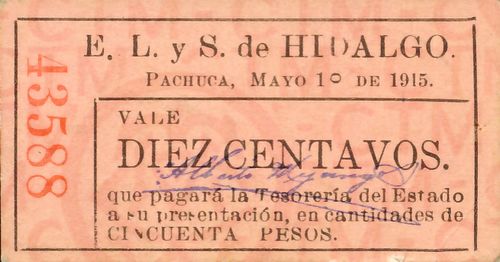

When Pachuca was under the control of the Villistas in July, they took $3,000 in these 10c cartones from the government printing office and put them into circulation, using them to pay their troopsAGN, Fondo Gobernación Periodo Revolucionario, caja 93, exp. 36, folletos 8 Secretario general L. de la Vega to [ ], Pachuca, 20 August 1915.
When Miguel Gómez Noriega handed over the government on 2 August, there was $59,624.15 in cash, mostly in Veracruz notes and other notes of forced circulation, with just over $5,000 in these valesAGN, Fondo Gobernación Periodo Revolucionario, caja 93, exp. 36, folletos 8 Secretario general L. de la Vega to [ ], Pachuca, 20 August 1915.
On 9 September the Secretaría de Gobernación replied that Carranza had only authorized this issue out of the dire necessity for change. The authorization was for $500,000 (in 5c, 10c, 20c and 50c) but to normalize affairs the Executive acknowledged the $348,756.00 (though in 20c, 25c and 50c). However, since the aim was to unify the currency, this money should be replaced as fast as possible by Gobierno Provisional cartones, which the Tesorería General de la Nación could provide in exchange for any legal paper currency. Moreover, they should declare the $3,000 taken by the Villistas null and void, and that the holders should hand them in to the Dirección de Rentas, under threat of fines or arrest, and that it should be decommissioned in the Oficina RecaudadoraAGN, Fondo Gobernación Periodo Revolucionario, caja 93, exp. 36, folletos 8.
There were in fact four values, with no 5c and with the 20c a different design to the others. Did they produce three values (10c, 25c and 50c) in a single format, then realize that they had produced a 25c note instead of the 20c note specified in the decree? The 50c are known on white paper.
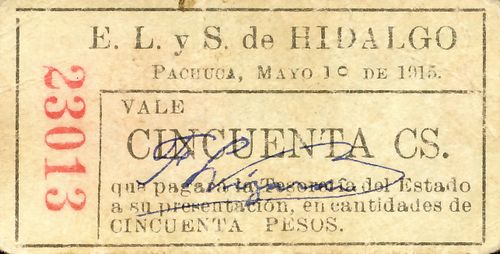
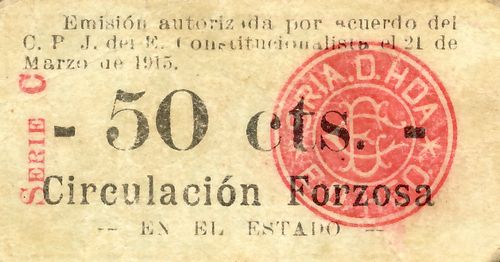
Machuca's authorisation states that the notes should be autographed by the governor, Secretario de Gobernación or Secretario de Hacienda. The signatures/initials are of Alfredo J. Machuca, Alberto [ ][identification needed] and Fernando Lizardi.
|
Alfredo J. Machuca was born in Oaxaca. He joined the Revolution in October 1910 and after Madero’s victory, served in the Tesorería General de la Nación, and in the army. On Huerta’s usurpation he disowned him, was briefly arrested but escaped, and was a member on Lucio Blanco’s staff, who appointed him teniente coronel and Comandante Militar of Oaxaca. On 11 November Carranza made him a coronel and jefe de armas of Córdoba and surrounding areas of Veracruz. On 13 February 1915 he moved to Hidalgo as Comandante Militar and then Governor. He served as governor for several short periods from 23 February, when General Fortunato Maycotte left the city to pursue the Villistas, until 12 July. 0n one occasion, from 25 June until 3 July, he was substituted by Fernando Lizardi (see infra). In June 1915 he took command of the right wing of the column that attacked Mexico City and, despite setbacks, on 11 July led his troops into the city. He then served in several campaigns putting down opponents of Carranza’s regime. He took part in de la Huerta’s rebellion in 1923 and on 4 April was arrested along with General Maycotte in Oaxaca and sent to Puebla for judgement. |
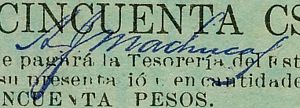 |
| Alberto [ ][identification needed] |  |
| Fernando Lizardi was Secretario General and served as substitute governor from 25 June until 3 July 1915. | 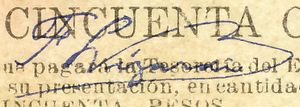 |
Known series are
| Series | from | to | total number |
total value |
||
| 10c | A | includes number 43588 | ||||
| B | includes numbers 14527CNBanxico #4451 to 27380CNBanxico #11211 | |||||
| C | includes numbers 31761 to 32004CNBanxico #4449 | |||||
| D | includes number 13669CNBanxico #4452 | |||||
| E | includes numbers 26134CNBanxico #4448 to 32899 | |||||
| 20c | includes numbers 389 to 21880CNBanxico #4453 | |||||
| 75,024 | 18,756 | |||||
| 25c | D | includes numbers 16179 to 20742CNBanxico #4454 | ||||
| E | includes number 02560 | |||||
| I | counterfeit | |||||
| 120,000 | 30,000 | |||||
| 50c | C | includes number 23013 | ||||
| E | includes number 06576 | |||||
| F | includes numbers 23041 to 40149CNBanxico #4455 | |||||
| G | includes number 26052CNBanxico #11213 | |||||
| J | includes numbers 22198 to 25719CNBanxico #4456 | |||||
| 600,000 | 300,000 |
Counterfeits
On 2 September 1915 the government issued a warning about counterfeit 25c cartonesPeriódico Oficial, Hidalgo, Tomo LXVIII, Núm. 45, 8 September 1915 though the notice covers green, i.e. 50c, cartones.
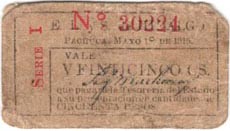
(Banco de México collection #11212)
The most notable differences were:
| GENUINE | COUNTERFEIT |
| printed on poor thick cardboard with a light green background (impresos en cartoncillo grueso y de mala clase, con fondo verde claro, afectando los dibujos de éste, un cuadrado) | printed on better quality cardboard with a dark green background (impresos en cartoncillo de mejor calidad y fondo verde obscuro y los dibujos de éste afectan ramas de laurel con pequeños lazos entre éstos) |
| signature is clear | signature is badly printed and smudged (medio borrada) |
| Numbers are scarlet | dull red (rojo obscuro) |
| 'No.' is aligned with the number | 'No.' slopes to the right |
| 'P' of 'Pachuca' is below the point of the 'L' of 'E.L.S. de Hidalgo' | 'c' of 'Pachuca' is below the point |
| '5' of '1915' is centred below the 'GO' of 'HIDALGO' | '5' is below the 'G' of 'HIDALGO' |
| The seal on the reverse is well finished and the letters of the mongram thin (el sello del reverse está bien acabado y las letras del monograma son delegadas) | letters and monograms are of a thick type (tipo grueso) |
| The 'm' of 'Emisión' is above the initial 'J'” | 's' of 'Emisión' is above 'J' |
| Cut by machine | Cut by hand |
